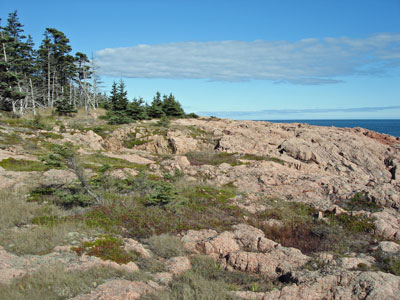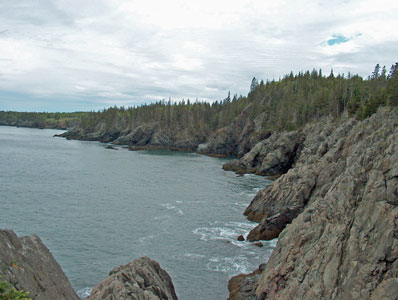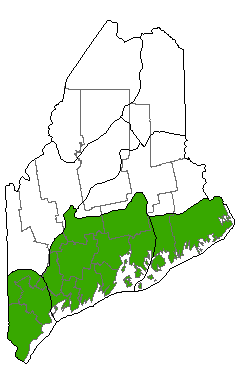DACF Home → Bureaus & Programs → Maine Natural Areas Program → Communities, Plants, and Animals → Natural Community Fact Sheets → Open Headland
Printer Friendly Fact Sheet - 820 KB pdf (Get a free copy of Adobe Acrobat Reader)
Open Headland
Scientific Name: Seaside Goldenrod - Goosetongue Open Headland; State Rank: S4

- Community Description
- Soil and Site Characteristics
- Diagnostics
- Similar Types
- Conservation, Wildlife and Management Considerations
- Distribution
- Characteristic Plants
- Associated Rare Plants
- Associated Rare Animals
- Examples on Conservation Lands You Can Visit
Community Description: In this community patchy herbaceous vegetation of seaside goldenrod, goosetongue, bluebell, and yarrow covers coastline bedrock. Overall vegetation cover is usually 10-35% but may be locally more extensive. Crowberry or creeping juniper may be present, but they do not cover extensive areas. Downeast of Acadia National Park, species of the Canadian Maritimes may be present, such as roseroot, beachhead iris, marsh-felwort, and glabrous knotted pearlwort. The primary bryoids are crustose lichens on the rock, including the lime-green map lichen and bright orange Xanthoria lichen. Where the forest edge abuts, cover is more dense, and often includes shrubs such as meadowsweet, currants, or small white spruce. Back to top.
Soil and Site Characteristics: Sites occur on bedrock areas exposed to salt spray and storm tides, typically between the high tide line and the upland forest. Sites are flat to sloping, and plants grow in the fissures of the rock or in small depressions with almost no soil. Back to top.

Diagnostics: Sparse herb dominated vegetation occurs on oceanside bedrock. Back to top.
Similar Types: Downeast Maritime Shrublands share many species, but these have more vegetation (usually >50% total cover and >25% shrub or dwarf shrub cover) and are dominated by shrubs rather than herbs. Rose Maritime Shrublands are dominated by shrubs >1 m tall. Back to top.
Conservation, Wildlife and Management Considerations: This type is well distributed along the Maine coast. Many sites are on public lands or private conservation lands. Some areas receive moderate to heavy foot traffic. To the degree that users remain on the bare rock, impacts can be minimal.
Rocky headland communities, especially those that occur on uninhabited islands, may provide nesting habitat for some oceanic bird species. Back to top.
Coastwide, largest occurrences east of Penobscot Bay. Extends into the Canadian Maritimes and south to Massachusetts (Laurentian Mixed Forest Province and Eastern Broadleaf Forest Province). Landscape Pattern: Small Patch. Back to top.


Characteristic Plants: These plants are frequently found in this community type. Those with an asterisk are often diagnostic of this community.
- Herb
- Bluebell
- Bluejoint grass
- Gall of the earth
- Goosetongue
- Red fescue
- Roseroot*
- Seaside goldenrod*
- Yarrow
There are no documented rare animals associated with this natural community.
Examples on Conservation Lands You Can Visit
| Example | County |
|---|---|
| Acadia National Park | Hancock Co. |
| Cutler Public Lands | Washington Co. |
| Great Wass Island Preserve | Washington Co. |
| Petit Manan National Wildlife Refuge | Washington Co. |
| Quoddy Head State Park | Washington Co. |